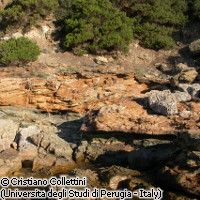Solid as a rock?
Geologic fault weakening and hence earthquake potential strongly depend on the rock's make-up and the distribution of weak minerals in the material, a new partly EU-funded study in the journal Nature suggests. The researchers from Italy and the US conducted friction experiments on rocks from the Zuccale fault on the island of Elba, Italy. Part of this research was funded through a European Research Council (ERC) Starting Grant. The project UNSEMS ('Uncovering the secrets of an earthquake: multidisciplinary study of physico-chemical processes during the seismic cycle') received EUR 2 million to improve our understanding of the mechanisms underlying earthquake generation. The analyses show that, while some faults might appear strong and stable, they may still be prone to slips and slides due to the distribution of small patches of weak minerals made up of talc and clay. Even if these minerals only constitute a small percentage of the fault rock, they will reduce friction and thus stability. The same is true of a layered (foliated) rock structure, the researchers explain. Samples with well-developed foliation are much weaker than their powdered equivalents. Frictional sliding occurs along very fine-grained layers composed of phyllosilicates - weak minerals such as talc - that effectively lubricate the fault zone. 'Low-angle normal faults - faults that dip less than 45 degrees - are a problem,' said Dr Chris Marone, professor of geosciences at Penn State University in the US. 'Standard analysis shows that these faults should not slip because it is easier to form a new fault than to slip on this orientation.' Standard tests could not shed light on this phenomenon. 'The standard way to test the friction of the rocks in a fault is to take some of the rock and grind it up into a powder,' Dr Marone continued. 'The powder is then tested in an apparatus that applies shear forces to the materials measuring the amount of force it would take to move sides of the fault. 'Normally the rock we use from fault zones comes from below the surface and we only get small amounts to work with,' Dr Marone went on to say. 'With the samples from Elba we could use a rotary cutter and carve a wafer from the rock with the same orientation that would slip in the ground. 'These low-angle normal faults do not look like they will do anything but creep along, but they could have earthquakes,' said Dr Marone. 'There are places in central Italy, for example, where faults like this have had small earthquakes.'
Countries
Italy, United States



